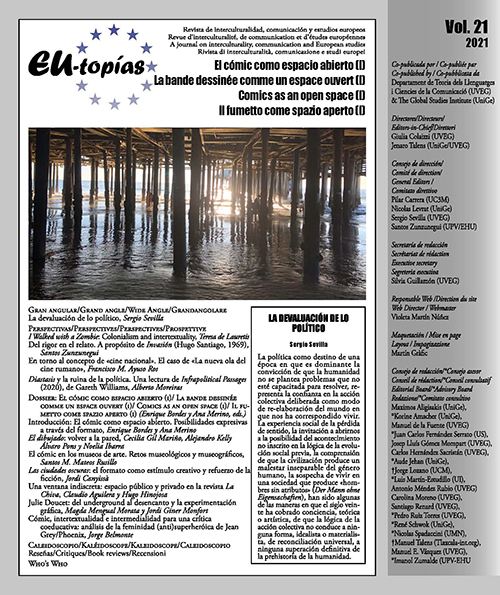An indiscreet window: public and private space in La Chiva magazine
DOI:
https://doi.org/10.7203/eutopias.21.21270Keywords:
La Chiva, comics, city. Abstract
Abstract
The end of the sixties marks a moment of deep changes in Chilean society. Added to the incipient process of political polarization, the city of Santiago begins to grow disproportionately, with no clear planning, and so does the overall number of the city’s population. At the same time, the process of uncontrolled urban development displaced entire communities, who were forced to gather in makeshift homes at the city’s outskirts, forming communities which proliferated in shanties on the vacant lands. In this context, the humor magazine La Chiva was founded in 1968 by four young Chilean cartoonists. Through its different sections, such as «Santiago tal cual» or «De La Vega a Vitacura», the magazine became a detailed showcase of the city in transformation. The article will focus on an exploration of some of the most memorable stories, such as “Lo Chamullo” and, especially, “La Ventana indiscreta”, creations of the renowned local artist Hervi, which allow an acknowledgment of the innovative character of the artist’s work in the field of Chilean comics. The constant flirtation with formal exploration, the direct dialogue with social contingency, the interplay with the language of comics, and the city read as a comic strip, are some of the aspects discussed in the text. Likewise, in the light of recent research on the relationships between architecture and comics, the article also aims to account for the particularities of such series and to formulate a reading within the framework of the social, political, and urban context of the time, particularly in the city of Santiago de Chile.
 Downloads
Downloads
 References
References
Aguirre, B., Rabi, S. «La trayectoria espacial de la Corporación de la Vivienda (CORVI)». Revista Electrónica DU&P. Diseño Urbano y Paisaje. 18 (VI), 2009. Centro de Estudios Arquitectónicos, Urbanísticos y del Paisaje. Universidad Central de Chile Santiago, Chile. Diciembre 2009. Consultado en http://dup.ucentral.cl/pdf/18_trayectoria_espacial_b.pdf
Barbieri, Daniele. Los lenguajes del cómic. Barcelona: Paidós, 1993.
Bordes, Enrique. Cómic, arquitectura narrativa. Madrid: Cátedra, 2017.
Cardoso, Armindo. «Población callampa, Santiago de Chile 1971». Archivo Fotográfico. Disponible en Biblioteca Nacional Digital de Chile http://www.bibliotecanacionaldigital.gob.cl/bnd/637/w3-article-156309.html
Cohn, Neil. «The limits of time and transitions: Challenges to theories of sequential image comprehension». En Studies in Comics, 1(1), 2010
De Ramón, Armando. Santiago de Chile (1541-1991): Historia de una sociedad urbana. Santiago: Catalonia, 2018.
Espinoza, Vicente. Para una historia de la ciudad de los pobres. Santiago: Ediciones SUR, 1988.
Garcés, Mario. Pan, trabajo, justicia y libertad. Las luchas de los pobladores en dictadura (1973-1990). Santiago: Lom Ediciones, 2019.
García Peñalba, Mercedes. Signa, 23, 2014, pp. 687-713.
Groensteen, Thierry. Système de la bande dessinée. Paris: Presses Universitaires de France, 1999.
King, Frank. «Gasoline Alley. Sunday newspaper comic, 24 de mayo de 193». Masters of American Comics. Paul Karasik. United States: Yale University Press, 2005.
Martin Franco, Emma. Temporalidad en el Cine y en el Cómic: Fugacidad y Eternidad [Tesis de máster]. Barcelona: Facultutat de Gegrafia i Història, 2016. Consultado: http://diposit.ub.edu/dspace/bitstream/2445/
103313/1/TFM%20Martin%20Franco.pdf
McCloud, Scott. Entender el cómic. El arte invisible. Bilbao: Astiberri, 2019.
Mikkonen, Kai. The narratology of comic art. New York: Routledge, 2017.
Montealegre, Jorge. Hervi, desde Chile. Alcalá de Henares: Instituto Quevedo de las artes del humor, 2019.
Mundt, Tito. Guía humorística de Santiago. Santiago: Zig-Zag, 1966.
Palomo, José y Hernán Vidal, Alberto Vivanco y Jorge Vivanco. La Chiva. Santiago de Chile: autoedición, 1968-1970.
Salazar, Gabriel. Movimientos sociales en Chile. Trayectoria histórica y proyección política. Santiago, Chile: Uqbar Editores, 2012.
Vidal, Hernán. Arquitectura e historieta. Entrevista inédita con los autores. Enero de 2021. Vía e-mail.
Vidal, Hernán, Carlos Reyes, Rodrigo Salinas y Rodrigo Dueñas, ed. La Chiva, ¡Y qué jué! Santiago de Chile: Feroces editores, 2011.
Vivanco, Alberto (dir.). El Pingüino. Santiago de Chile: Editorial Lord Cochrane. Sin año. Números 531 y 544.
Ware, Chris. Jimmy Corrigan, the smartest kid on earth. United States. Pantheon, 2003.
Downloads
Published
How to Cite
-
Abstract293
-
PDF (Español)202
Issue
Section
License
![]()
The authors conserve the copyright. All content published in EU-topías. Journal of interculturality, Communication, and European Studies are subject to the license Creative Commons Attribution-NonCommercial-ShareAlike 4.0 license. The full text of the license can be found at <http://creativecommons.org/licenses/by-nc-sa/4.0>
They may be copied, used, disseminated, transmitted and publicly displayed, provided that:
- The authorship and original source of the publication is cited (journal, publisher and URL of the work).
- They are not used for commercial purposes.
- The existence and specifications of this license of use are mentioned.
It is the responsibility of the authors to obtain the necessary permissions for images that are subject to copyright.



